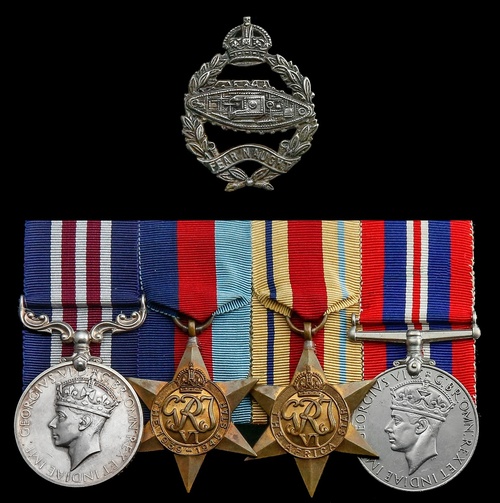
Auction: 17003 - Orders, Decorations and Medals
Lot: 705
(x) 'In the November gloom that last scene [at Sidi Rezegh], as the rear-guard guns slipped out of the action, was one to inspire awe in all beholders, as indeed its relics were to do for years to come. The hundreds of dead bodies, the flames of burning vehicles and ammunition, the twisted wreckage of guns, the still smouldering ambulances bombed by the German aircraft, the bullet-riddled trucks, the crushed German aircraft, the blackened hulks of British and enemy tanks, with their turrets, tracks and guns ripped off in scrap-heaps of mangled steel, and the roasted corpses hanging out of their turrets gave to that harsh desert the air of desolation, yet, to those who had eyes to see, it told also of innumerable acts of unrecorded heroism. Significantly, it told also of the destruction already of some 85 German tanks.'
Victoria Cross Battles of the Second World War, by C. E. Lucas Philips, refers.
A fine Second World War 'Desert Rat's' M.M. group of four awarded to Acting Sergeant L. Gosby, 3rd Royal Tank Regiment (R.A.C.), whose tank was knocked out at Sidi Rezegh in November 1941
Military Medal, G.VI.R. (7883192 A./Sjt. L. Gosby, R. Tank R.); 1939-45 Star; Africa Star; War Medal 1939-45, together with a Tank Regiment cap badge, scratches over number and after unit on the first, good very fine (4)
M.M. London Gazette 9 September 1942. The original recommendation states:
'At Sidi Rezegh on 22 November 1941, he commanded a tank, supported by his Squadron Commander, in an attack on anti-tank guns. When his Squadron Commander's tank was put out of action by enemy fire, he pushed further forward to enable the crew to evacuate. It was then that his tank was put out of action. He evacuated his crew under heavy machine-gun fire and rendered first aid to the wounded operator. He then at the Rally Point took command of another tank and went into action with a Mixed Squadron in an attack on enemy anti-tank gun positions.
At Antelat on 23 December 1941, he showed cool courage in the face of enemy shell fire by removing a wireless receiver from one tank to that of his Squadron Commander when it was important that inter-communications should be maintained. He was largely responsible for the good communications within the Squadron throughout the whole the operations.
This N.C.O. displayed the greatest courage and was at all times a source of inspiration to all.'
Leonard Gosby was witness to some of the toughest actions of the Desert War, high on the list being Sidi Rezegh in late November 1941. On that occasion he and his comrades in 3rd Royal Tank Regiment - a unit of the famous 7th Armoured Brigade - were heavily engaged against Rommel's 21st Panzer Division. The fighting centred on the aerodrome, where, according to David Masters, 'The battle swayed to and fro for days, so deadly to both sides that the valley to the south of the aerodrome was dubbed Death Valley. At its height, when the tanks were going up in flames and the survivors were roaring and weaving about amid clouds of dust to kill their adversaries … there were many acts of heroism'; see With Pennants Flying, The Immortal Deeds of the Royal Armoured Corps.
By the time the 'Desert Rats' withdrew on the 22nd, all but four of their 150 tanks had been destroyed or put out of action. Brigadier 'Jock' Campbell was awarded the V.C., but with a total loss of another 520 tanks in four days of severe fighting, the Eighth Army's "Crusader" offensive was over; for further details see A View from the Turret: A History of the 3rd Royal Tank Regiment in the Second World War, by Major 'Bill' Close, M.C.
Subject to 5% tax on Hammer Price in addition to 20% VAT on Buyer’s Premium. For more information please view Terms and Conditions for Buyers.
Sold for
£1,000




